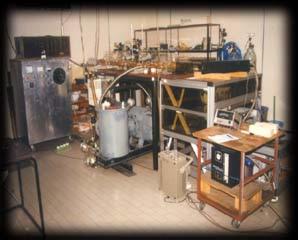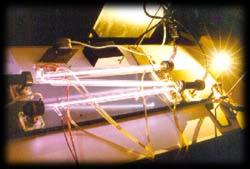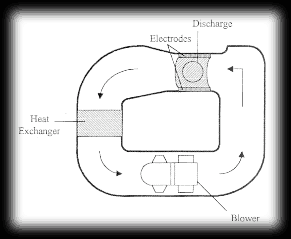C02 LASER
 C02 laser is a molecular gas laser and infrared
emission laser. The emission occurred on the two vibration rotational bands of C02
molecule at wavelength of 10.6 Ám in the infrared. It should be equipped with pulsed and
continuous wave (CW) modes of operation.
C02 laser is a molecular gas laser and infrared
emission laser. The emission occurred on the two vibration rotational bands of C02
molecule at wavelength of 10.6 Ám in the infrared. It should be equipped with pulsed and
continuous wave (CW) modes of operation.
To operate the laser in pulsed-mode, two different techniques have been used. In the first technique, no switching power supply was used. In this simple technique, the discharge impedance collapse caused by high voltage preionizer pulses has been exploited to produce laser pulsation. Using this method the laser has been operated in pulsed-mode up to 1.3 kHz frequency, with 100% amplitude modulation depth and with a peak to average power ratio of 3.35. In second technique, the discharge current has been pulse width modulated using a switched-mode power supply to operation the laser in pulsed-mode up to 1kHz frequency.

 There are many different types of design for the CW C02
laser, which generally can be divided into three different groups of slow
flow, sealed-off and fast-flow laser
system.
There are many different types of design for the CW C02
laser, which generally can be divided into three different groups of slow
flow, sealed-off and fast-flow laser
system.
Seal off C02
laser
In general, seal-off laser mean discharge gases are completely sealed within the
discharge tube. It offers convenient application because there are no vacuum and bottles
needed. Heat generated by the electrical discharge is removed by heat conduction through
by a water jacket. The output power can be increase only by increasing the discharge tube
length. This system is used up to about 100 W.
Slow flow C02
laser
Below is the schematic diagram of a slow flow (diffusion cooled) CW C02
Laser. It is relatively simple to design, build and maintain, and predominate in the range
100 - 400 W power output. The lasing gas is fed from high pressure cylinders into the
plasma tubes and flows slowly through them at a few metres per second. The maximum power
obtainable from the tube is also dependent on the length of the excited of the plasma
tube. Heat generated by the electrical discharge is also removed by heat conduction
through by a water jacket. Gas is slowly pumped through the tube in order to refresh the
gas mixture continuously.
Fast flow C02
laser
For a fast flow system, the heat absorbed by the C02 gas can
be removed by the flowing gas. This technique allows an increase of obtainable power per
unit length of discharge by several orders of magnitude. Multi kilowatt electrically
excited lasers in reasonable sizes can be built. The fast flow system can be divided into
two types, which are fast axial flow and fast transverse flow system.
In the fast axial flow (FAF) C02 laser the gas
mixture is forced through the tubes at velocities up to 400 m/s. It is re-circulated
through the tubes many times and after each passage through the discharge is cooled
directly in a heat exchanger. Roots type gas pumps are usually used in these lasers. 
Above is the schematic diagram of a fast axial flow C02 laser, which
the optical axes, current and gas flow are in the same direction. The laser's power output
is no longer dependent on the length of the discharge tubes. However, largely on the rate
of mass flow of gas through them. Laser power therefore be increased either by increasing
the volume flow rate or the pressure of the re-circulated gas, provided no other
mechanical or electrical limitations. In practice the power output of a FAF C02
laser may be limited by one or more factors as below:
- volume flow rate of the gas
 Above about 8 kW, fast transverse flow is most efficient, and power
in excess of 25 kW can be obtained, In this system, the lasing gas flows in a channel at
the right angles to the resonators5 axis. On the right shows the schematic diagram of a
fast transverse flow C02 laser, which the optical axes is perpendicular to
the discharge current and gas flow. The area of the gas flow path can be made much larger
than that in FAF laser. Consequently the flow resistance and thus the power required to
drive the gas re-circulating pump is much reduced.
Above about 8 kW, fast transverse flow is most efficient, and power
in excess of 25 kW can be obtained, In this system, the lasing gas flows in a channel at
the right angles to the resonators5 axis. On the right shows the schematic diagram of a
fast transverse flow C02 laser, which the optical axes is perpendicular to
the discharge current and gas flow. The area of the gas flow path can be made much larger
than that in FAF laser. Consequently the flow resistance and thus the power required to
drive the gas re-circulating pump is much reduced.